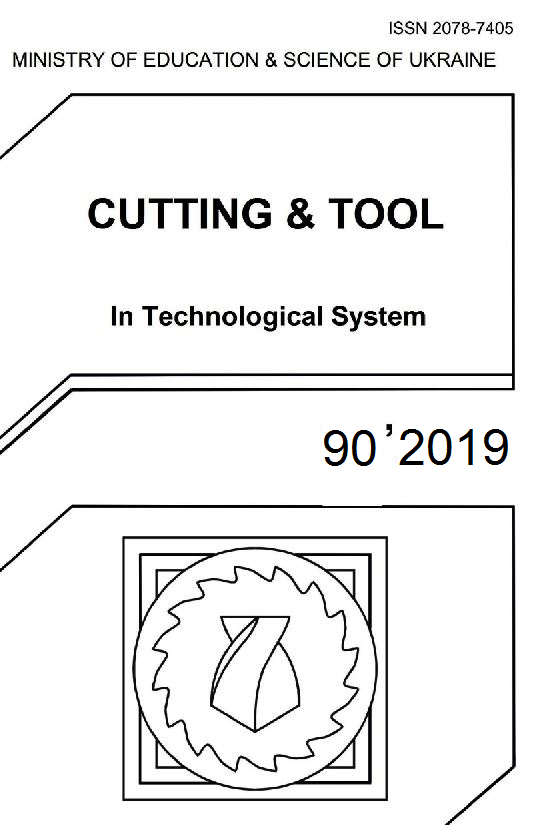INFLUENCE OF PROPERTIES OF METAL-CATALYST IN DIAMOND GRAINS ON STRESSED-DEFORMED STATE OF THE DIAMOND-LAYER ON THE STAGE OF MANUFACTURING THE TOOL
DOI:
https://doi.org/10.20998/2078-7405.2019.90.13Keywords:
diamond grain, metal phase, stress-strain state, ceramic bundle, heat-resistant solvent alloys.Abstract
One of the most significant factors affecting the heat resistance of a synthetic diamond is the presence of metallic inclusions in it, which are inevitably present after its synthesis and lead to an increase in internal pressures in the crystal, the appearance of a network of microcracks and metallophase migration on its surface during heating. Taking into account the high temperature load experienced by the diamond layer during sintering of grinding wheels, it becomes necessary to study the effect of the physical properties of the solvent-alloy (metal phase) on the change in the stress-strain state of the binder – diamond grain – metal phase system. The results of 3D modeling by the finite element method of sintering the complex system “bond – diamond grain – metal phase” allow predicting its behavior ensuring the integrity of the diamond grains during the manufacture of an abrasive tool. The influence of the physicomechanical properties of the metal phase, as well as its percentage in the diamond grain, on the stress-strain state of the “binder – diamond grain – metal phase” system has been established for the first time while studying the sintering process. The most heat-resistant types of alloys-solvents were established: Co – Cr, Ni – Fe – Cr, Fe – Co – Cr, which ensure the integrity of the grains at the stage of manufacturing (sintering) diamond circles on ceramic bonds by reducing the value of reduced stresses in the system in 1, 7 ... 2.1 times. Studying the effect of the physicomechanical properties of the metal-catalyst (alloy-solvent) on the stress-strain state of the system under study allows determining their rational values for various grades of diamond, which may be of practical value in the synthesis of diamond.References
Novikov N. V. Sintez almazov / N. V. Novikov, D. V. Fedoseev, A. A. SHuljenko i dr. – Kyiv: Nauk. dumka, 1987. – 160 p.
Instrumentyi iz sverhtverdyih materialov / Pod. red N. V. Novikova. – Moskow: Mashinostroenie, 2005. – 555 p.
Novikov N. V. Metodika opredeleniya prochnosti i treschinostoykosti polikristallicheskih sverhtverdyih materialov / N. V. Novikov, I. M. Androsov, A. L. Maystrenko // Sverhtverdyie materialyi. – 1988. – № 2. – pp. 33–37.
Maystrenko A. L. K voprosu o mehanizme razuprochneniya kristallov sinteticheskogo almaza pri vyisokotemperaturnom nagrevanii / A. L. Maystrenko, A. I. Borimskiy, L. N. Devin i dr. // Porodorazrushayuschiy i metalloobrabatyivayuschiy instrument – tehnika i tehnologiya ego izgotovleniya i primeneniya: Sb. nauch. tr. – Kyiv: ІNM іm. V. M. Bakulya NAN Ukraїni, 2010. – Vip. 13. – pp. 272–279.
Kozakova N. V. Opredelenie ratsionalnyih harakteristik almaznyih krugov putem 3D modelirovaniya protsessov ih izgotovleniya i shlifovaniya sverhtverdyih materialov: Dis. ... kand. tehn. nauk: 05.03.01. – Harkiv, 2005. – 210 p.
Downloads
Published
Issue
Section
License
Copyright Notice
Authors who publish with this Collection agree to the following terms:
1. Authors retain copyright and grant the Collection right of first publication with the work simultaneously licensed under a Creative Commons Attribution License that allows others to share the work with an acknowledgement of the work's authorship and initial publication in this Collection.
2. Authors are able to enter into separate, additional contractual arrangements for the non-exclusive distribution of the Collection's published version of the work (e.g., post it to an institutional repository or publish it in a book), with an acknowledgement of its initial publication in this Collection.
3. Authors are permitted and encouraged to post their work online (e.g., in institutional repositories or on their website) prior to and during the submission process, as it can lead to productive exchanges, as well as earlier and greater citation of published work.

